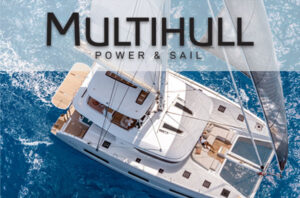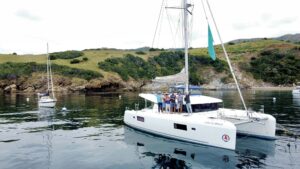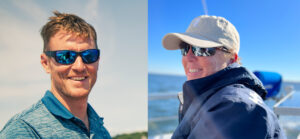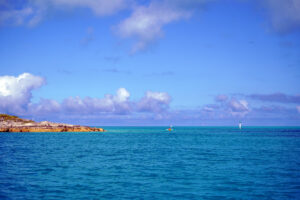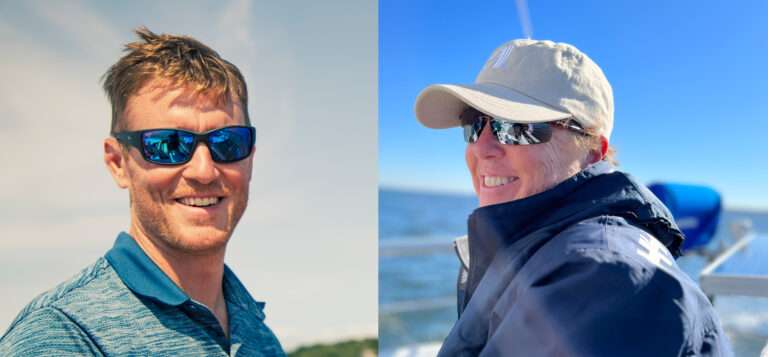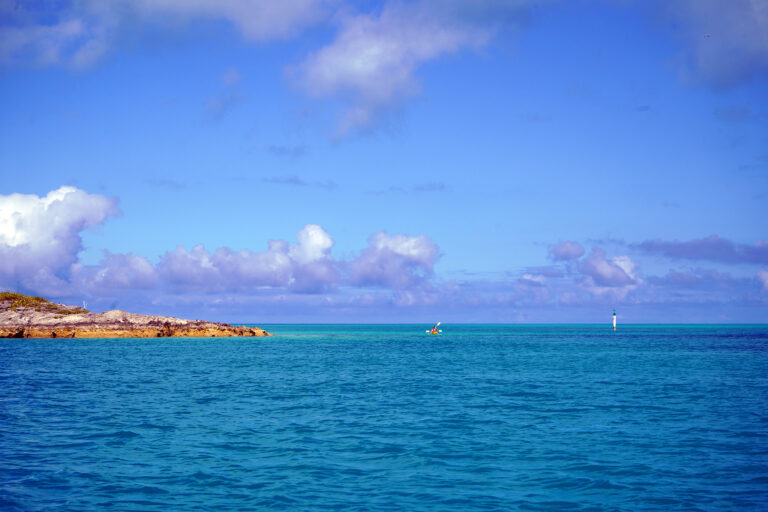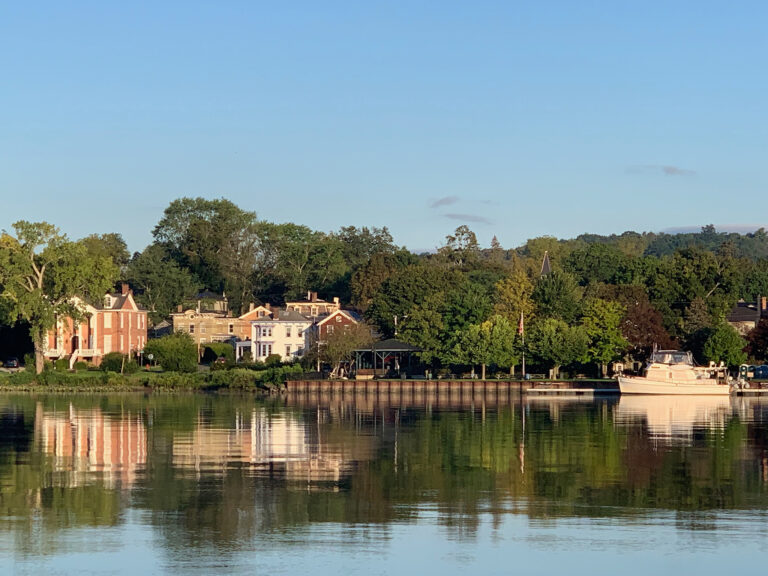Tucked away down a narrow alley in the picturesque town of Ashburton, on the edge of Dartmoor National Park in England, is a tiny building called the Tenter loft, a relic from the ancient wool industry when cloth was stretched on tenterhooks. It’s now the quirky office of British multihull designer Nigel Irens, the man behind some of the fastest sailing boats on the planet.
“The only things stretched in here are catamarans and trimarans,” says one of his team in a play on Irens’s maxim on multihull design that can be paraphrased as “design the longest boat you can possibly accept and then add a few feet.”
For 40 years, Irens has been at the cutting edge of multihull ocean racing. His name is on a string of record-setting catamarans and trimarans that are bywords among multihull aficionados everywhere, including ENZA, the 92-foot cat on which Peter Blake and Robin Knox-Johnston set the first Jules Verne sailing record in 1994; iDEC, on which Francis Joyon became the fastest man to circumnavigate solo; B&Q Castorama, on which Ellen Macarthur became not just the fastest woman around the world but, for a while, the fastest person, period. These and many other designs have long been celebrated as a kind of fusion of art and science. Irens’s designs, built for speed and endurance, have been called poems of flowing function, and for decades have been sought after by the hottest sailors on the race circuits.
At 67, Irens is as busy as ever. He jokes about “reaching the sun-filled plateaus” of retirement, but quickly adds, “I’ve always got an ambition for the next project.” And the projects keep flowing, just like the River Ashburn, which burbles, literally, underneath his office. We might be 20 miles from the sea, but the rush of water for Irens is a 24-hour soundtrack.
“I’ve been fascinated by water and slippery boats my whole life,” says Irens, who in his student days in the 1960s lived on an old workboat on the River Hamble while he studied for a diploma in Boatyard Management at Southampton College of Technology. His liveaboard neighbor was SAIL Magazine writer Tom Cunliffe. Both were impoverished students who lived in fear of the harbormaster’s visit to collect harbor dues. Irens was even Honorary Commodore of the Old Gaffers’ Association in 1970. Who would have guessed that 40 years later he’d design a wooden gaff cutter, Westernman, for Cunliffe, let alone generate a string of maxi multihulls and become a consultant for the America’s Cup?
Irens’s love for sailing (and multihulls) goes back to family holidays on his father’s 30-foot plywood catamaran, in which they crossed the English Channel to France and cruised St-Malo, La Roche Bernard and the canals.
In the early 1970s Irens was working in a boatyard on the River Severn with multihull pioneer Paul Weychan, building what was claimed to be Europe’s biggest trimaran, the 52-foot Tacitimu, a Polynesian word for “Outrigger of the Gods.” In 1972 Irens and a friend opened a sailing school in Bristol, and by 1977 he had designed his first boat, Promenade, a 60-foot cruising trimaran that’s still chartering today in the British Virgin Islands. In 1978 Irens salvaged the wreck of a 31-foot Dick Newick Val Class trimaran, Jan of Santa Cruz, and shipped her from the Canary Islands to the UK to rebuild with legend-to-be Mike Birch. Together with friend Mark Pridie, Irens sailed her to class victory in the 1978 doublehanded Round Britain and Ireland Race. She became the launch pad for his career.
Secrets of Speed
Nigel designed his first racing trimaran, the 40-foot Gordano Goose, in 1980 and built her in a barn in Easton-in-Gordano, near the River Avon outside Bristol. Her highly rockered hulls showed Newick’s influence, but Irens’s first-hand seagoing experience and guidance from a structual engineer gave him the confidence to push the envelope. Gordano was low-slung, with a slim central hull and low windage. The turtleback cabin created a compression beam from end to end to handle the rigging loads. She was a true “next generation” tri and reportedly one of the first to almost sail on one ama.
Famously, Gordano Goose was the tri in which Irens beat Eric Tabarly, Mike Birch and Philippe Poupon in a memorable 24-hour singlehanded race out of St-Malo in 1981. “By the grace of God the weather was squally with changing wind directions, and my boat was smaller and more manageable, though I still had 17 sail changes! When the sun came up on the second day, I had no idea where I was and exhaustion had set in. At the last windward buoy, I saw Philippe Poupon, in a similar sized tri, ahead of me. I thought ‘Wow, second place, amazing!’ Then Poupon hoisted his starcut spinnaker—and promptly ran over it!” Irens overhauled him to win the £4,000 prize, “a king’s ransom” in those days.
“I had a huge escort to the finish line,” Irens says, smiling at the memory. “It was as if I’d won a round-the-world race.”
He adds—most emphatically—that this was his “first and last attempt at a solo race,” but that didn’t stop him from designing British sailor Tony Bullimore’s 40-foot trimaran IT82, in which the two of them won their class in the 1982 Round Britain Race. (Bullimore would go on to chalk up third in class aboard IT82 in the 1984 Observer Singlehanded Transatlantic Race.)
After that came another trimaran design for Bullimore, the beautifully sculpted 60-footer, Apricot. Part of Nigel’s genius has long been to enlist outside talent and skills—people like Martyn Smith, then ex-Chief Engineer for British Aerospace, who designed the Concorde’s nose cone—and the approach is much in evidence in this design. Smith, for example, took over the structural composite work, while the boat’s 78-foot carbon wing mast was designed by Barry Noble, a former sparmaker who was then making carbon-fiber violins and cellos.
The result was music to their ears—a state-of-the-art tri that Bullimore and Irens sailed to outright victory in the 1985 Round Britain Race. They also won their class in every leg of the Round Europe Race that year. Their reward was to be jointly elected Yachtsmen of the Year at the London Boat Show.
“I look back on those racing days with huge pleasure, but I’m not a natural ocean sailor,” says Irens. “I spend my time lurching between fear and boredom. I like to be able to see the land. A French journalist once asked me about this. The French are in love with the romance of the sea, and I think he was a bit shocked. I’m probably regarded as a bit of a Philistine!”
In between IT82 and Apricot, Irens designed what was then the world’s longest racing catamaran—the 80-foot carbon fiber/Kevlar Formule Tag, built for Canadian Mike Birch in Montreal. Tag was built by Canadair using aerospace technology. The largest ever pre-preg structures were “cooked” in giant ovens. Irens moved to Montreal to oversee her build. Launched in 1983, she was the first multihull—and the first racing sailboat—to beat the 500-mile-a-day barrier, clocking 517 miles in 24 hours during the 1984 transatlantic Quebec-Saint-Malo race.
Ten years and thousands of miles later she was stretched to 92 feet, re-named ENZA New Zealand, and circled the world. The extra length boosted her performance by 15 percent. A new accommodation module—the “god-pod”—was built into the center main beam for co-skippers Peter Blake and Robin Knox-Johnston.
Irens was in Brest, France, when they sailed across the finish line in 1994 after 74 days and 22 hours to win the Jules Verne Trophy. The remarkable old warhorse was later campaigned in round-the-world races by Tracy Edwards as Royal & Sun Alliance (dismasted) and was stretched to 102 feet by Tony Bullimore and sailed as Team Legato in The Race (2001).
After that she was Daedalus for a while, and then Doha. In 2010, in her last incarnation as Spirit of Antigua, she capsized in the Bay of Biscay. She now lies forlorn in Brest, stripped of gear, a ghost from ocean racing history.
Never one to dwell on the past, Irens is now excited by his latest hi-tech catamarans, two custom designs for private clients undergoing sea trials this summer in Britain and Middle East.
Going Production
Irens has also been working with Gunboat, designing the new 55 and 60 models. It’s the first time he has been involved with a production builder. With typical modesty, he’s never cashed in on his reputation and admits he could have been much richer if he’d been more commercially minded.
Gunboat’s founder and CEO Peter Johnstone, having redefined the luxury catamaran market, was looking for a fresh approach after 10 years with Morrelli & Melvin Design. He turned to Irens, whose record-breaking multihulls have never suffered major damage. Speed and reliability are indispensable qualities in ocean cruising cats.
“Working with Gunboat is a great opportunity to do a Rolls Royce job on research and development,” Irens says. “You don’t often get the chance to devote so much time to one boat.”
The cruising cat has been left behind, he adds. “Catamarans have always boasted plenty of space, but sailing them from A to B was more about ‘moving house’ than sailing.”
A consultant in 2008 for the Alinghi team, Irens also believes the America’s Cup has opened the door to more people having multihulls. “The glamour surrounding the event has legitimized the catamaran. We are all victims of fashion, and for many people catamarans were not seen as socially acceptable, because they didn’t sail well. The market for charter cats has been very successful, but performance has been dragged down by extra concessions to space and comfort, which add weight. Catamarans were simply not seen as the domain of someone with a big budget. But they will be now.”
For the new Gunboat 55 hull Irens has created a unique monocoque all-carbon structure that requires no forward crossbeam to support the hulls, thus reducing windage and drag. New furniture, cored with Divinycell foam, has reduced weight by half.
Another small innovation Irens has brought to Gunboat is “a simple little chine” on its new 60-footer, a development from Sodebo. Johnstone describes how one Gunboat sailed 2,000 miles and had spray on its deck only twice, once during a 45-knot gale. “Nigel’s chine made all the difference,” he said.
A lot of work has also been done on the design of the pivoting centerboards on the Gunboat 55 and 60, as Johnstone has become a centerboard evangelist after listening to Gunboat owners’ tales of daggerboard problems.
“The new centerboard mechanisms are complex and expensive and have gone through several evolutions,” says Irens, who brought in UK engineer Roger Scammell to help refine them, based on his experience working on the steering systems for Irens’s tri B&Q and the canting keels for a number of Open 60s.
The benefits of a centerboard are ease of adjustment—you can instantly balance the boat by adjusting the trim of the board(s)—less noise, less drag and improved interior space. The board is controlled by hydraulic rams and can be set at any depth and angle. It can even go 5 degrees forward of vertical, the normal position being vertical. If you hit something, the shear pin on the rams will break so the board kicks up without damaging the board or the mechanism
Innovative design, use of the latest materials, and the addition of a carbon rig supplied by Swedish company Marstrom Composite has helped increase speed. A rotating wing mast and a new beam arrangement permits tight sheeting angles for an upwind-oriented Code 0.
Johnstone is full of praise for Nigel’s input and notes that every hour spent in design has cut the production hours by a sizeable factor. “We do almost no cutting once the carbon fiber hull is built,” he says.
Irens has dispensed with superfluous cabins that weigh down the typical cruising cat and kill performance. But she still has two superyacht-worthy cabins, plus an owner’s study/workshop. Speed-wise, Johnstone says the 55 (which replaces the 48) will be similar to the 66, which he considers “a bit of a rocket ship.”
At press time, Irens’s radical Middle East “stealth” project, A65 was due to be unveiled at the Dubai Boat Show in March. “We’ve taken an oath of secrecy, but I’m very excited to see how she sails. I’ve never created a boat like this before, and the owner seems pleased with the performance,” he says.
“We’ve had priceless design discussions with six or seven people on conference call on Skype. The owner is a man after my own heart. Most boats are better for being longer with the same accommodation, but few people have the courage of their convictions. ‘Let’s do it!’ the owner said to me. So A65 is essentially a 53-footer on 65-foot hulls with a high-performance rotating wing mast and carbon rigging.
“No catamaran should suffer the excesses of wave-making drag. It’s ridiculous. By stretching her and creating a hull displacement-length ratio that doesn’t attract drag you have far better sea-keeping qualities. You’ve created a wave-piercing bow that acts just like the leeward hull of a trimaran. It’s the same thing we did with Sodebo, where there’s a chine to deflect spray. You get a much nicer ride with less pitching.”
Like the Gunboats, A65 has a forward cockpit and, unusually, tiller steering, plus two owners’ suites. She is built for long-distance performance cruising.
Also launching this summer is Irens’s other top secret project, APC78—a 78-foot Advanced Performance Cat being built in the UK by Green Marine, a company that’s also done America’s Cup challengers, Open 60s and Volvo Ocean Race boats. Built in carbon and Nomex, she will have composite rigging incorporating the smallest diameter carbon rigging on the market from Future Fibers.
Days of Future Past
This is all light years away from the Greyhound pub in Bristol, where in 1973, Irens was part of a syndicate eager to compete for a £500 prize in the World Sailing Speed Record trials at Portland Harbour near Weymouth. “We cleared out the pub after lots of arguing over design and had competitions for one-meter long models on a pond on Sunday mornings. People used to party until two in the morning and then build models until 10. There were 10 of us paying £50 each, plus unofficial sponsorship from the BBC—most of the materials came from a friend who worked there as a set designer. The result was a proa with five solid wing sails arranged like a vertical Venetian blind with trailing edge flaps.” Christened The Clifton Flasher, she could only sail on one tack. Nigel helmed her over the 500-meter course at a fastest speed of 22.14 knots.
Looking into the future, it’s pretty obvious that although the idea of lifting a sailing boat on to hydrofoils has been around for several decades, it is only now that real progress is being made in translating theoretical gains into tangible ones. The stunning performances demonstrated by Oracle Team USA and Team New Zealand as they joined in battle for the 34th America’s Cup was truly astonishing. It is surely only a matter of time before future development work will allow a similar quantum leap in performance to be demonstrated in the much more demanding arena of ocean racing.
“Interestingly, Michel Kermarec, a senior aerodynamicist for Oracle, showed us that a solid wing hardly pays. The lift-drag factor is spectacular, but it’s only on a very narrow band and not useful going upwind. A soft sail can still be pretty darn good. I’d love to do a foil-assisted, rather than foil-borne, freestanding rig.”
In fact, Irens is in the midst of working up just such a rig for a 46-foot yawl, Stern, he’s designed that is now being built in Sweden. But that’s a monohull, and we can’t discuss the “dark side” of Irens’s career in a multihull magazine! Rest assured he’s designed some beautiful monohulls. He’s drawn ocean-going fusion schooners (Farfarer, Glaz and Maggie B) and creek-crawling lugger yawls (Romilly and Roxanne). He can draw dayboats, world-girdling liveaboards and sci-fi looking powered trimarans, like ILAN Voyager (Incredibly Long and Narrow) and Cable & Wireless.
There are so many facets to Nigel Irens that it’s impossible to do the man justice in a few words.
There is Irens the Francophile, who lived in La Trinité-sur-Mer, in Brittany, for a few years. He speaks fluent French and with design partner Benoît Cabaret has produced the most exciting Anglo-French flying machines since the Concorde. “I draw the concepts, Benoît verifies and optimizes them,” he says.
Salute Irens the unsung hero. In 2005 he was awarded the highest honour in the UK for industrial design and became one of the Royal Designers for Industry, joining an exclusive club of 200 “members” alongside Apple’s Sir Jonathan Ive and Sir Tim Berners-Lee, inventor of the world-wide web.
Meet Irens the analog man. Swedish multihull expert Torbjörn Linderson says: “There is something about working with a person who is “pre digital” and whose performance ideas come from a deep understanding of the yacht as a whole, rather than just numerically driven. And he is just a great guy!” Irens is definitely an analog man without a slide rule. Self-taught and, like Dick Newick, a bit of a seat-of-the-pants designer, his skills are intuitive. “I’m just not a numbers man! I failed miserably at maths as a student. Design courses didn’t exist in those days, and even if they had, I’m not sure I’d have qualified.” Irens sketches his designs on paper and he can cut out the hull design with scissors and balance the template on the edge of a rule to confirm his ideas. He still makes models.
How about Irens the eccentric? “I sometimes wonder if I am,” he admits. Another sailing journalist characterized his unconventional design palette as “Rembrandt’s Cubist Period” and “Sid Vicious singing opera.”
Spare a thought for Irens the anxious. When you design rocketships sailed across lonely oceans, thousands of miles from land by solo sailors, you can suffer sleepless nights. When Ellen MacArthur sailed into Falmouth after 71 days he hugged her in relief and exclaimed like a concerned uncle: “Don’t you dare do anything like that again!” Ellen’s verdict on Irens’s B&Q: “She’s in better shape than I am!”
“Nigel is a purist,” adds MacArthur. “If he’s designing a boat to be fast it is fast, and if he’s designing a cruising boat it really does cruise. His boats all have identity, but what sets Nigel apart in my opinion is that all his boats have stunning lines as Nigel is also an artist. To top that he is one of the nicest people I have ever had the pleasure of working with, and I didn’t hesitate one second to put my life in his hands.”
Finally, there’s Irens the dad and family man. To see him sending his kids off to school (Juliette, 16; Katie, 5; Sam, 14), meet his delightful wife, Alison, not to mention Bella the Siamese cat, and join the ritual walk round town with Ellie the springer spaniel is to wonder how he finds time to be a design genius. Clearly, though, he does.
Irens designs over the years
1977 60-foot cruising trimaran Promenade built for Caribbean charter; still sailing in the BVIs today
1980 40-foot racing trimaran Gordano Goose built
1982 40-foot racing trimaran IT82 wins its class in Round Britain race
1982 50-foot racing catamaran Vital takes third overall in the Route du Rhum
1983 80-foot racing catamaran Formule Tag is built; in 1984 she sets new 24 hour record of 512.5 NM
1985 60-foot racing trimaran Apricot wins 1985 Round Britain Race with Irens and Tony Bullimore as crew
1986 75-foot racing trimaran Fleury Michon VIII takes first overall in Route du Rhum
1987 60-foot racing trimarans Fujicolor and Laiterie Mont St Michel launched
1987 40-foot Formula 40 catamaran Data General takes second overall in the Formula 40 Championship
1988 70-foot power trimaran Ilan Voyager wins Round Britain Powerboat record in 72 hours at an average speed of 21 knots with no fuel stops. 60-foot trimarans Fleury Michon IX and Laiterie Mont St Michel are first and second in the Carlsberg singlehanded transatlantic race
1990 60-foot racing tri Fujicolour II launched
1992Fujicolor II wins Europe 1 solo Transatlantic Race
1994ENZA New Zealand (ex-Formule Tag) wins Jules Verne Trophy as fastest boat to sail non-stop round the world, following a 74-day circumnav
1996 Three Irens designs—Fujicolor II, Region Haute Normandie and Biscuits La Trinitaine—win all three places in the Europe 1 Single-Handed Race
1998 115-foot power trimaran Cable & Wireless launched and sets a new round-the-world record, motoring 22,600 miles in 74 days
2002Bayer Crop Science built; it’s one of the first mutihulls built in Nomex sandwich carbon prepreg resin for lightness and rigidity
2004 75-foot trimaran B&Q Castorama built for Ellen MacArthur; a year later MacArthur sets a new solo round-the-world record of 71 days 14 hours
2007 105-foot trimaran Sodebo, designed for Thomas Coville to beat Ellen MacArthur’s solo record, is launched in Sydney; 97-foot trimaran IDEC 2 is launched for Francis Joyon and sets a new 24-hour solo record of 616 miles
2008IDEC 2 sets a new round-the-world solo record of 57 days, 13 hours, smashing the previous record set by MacArthur; Irens is appointed consultant to the Alinghi design team as they prepare to defend the America’s Cup. Sodebo breaks a new 24-hour record of 620.8 miles and establishes a new solo west-east transatlantic record of 5 days 19 hours.
2010 Oman’s flagship multihull, the 105ft trimaran Oman Air—a sister ship to Sodebo—breaks the non-stop solo Round Britain record in 4 days 15 hours.
2010Paradox, a 62ft carbon racer/cruiser trimaran, is built using the molds of Loick Peyron’s trimaran Fujifilm. She averages 300-350 miles a day offshore.
2012 The SeaRail 19, a production trailable trimaran, is built in Vietnam for the American market.
2013 The Gunboat 55 and 60 catamarans go into production; Green Marine in the UK start building APC78 (Advanced Performance Catamaran). In Cherbourg, French yard CMM start building three Ocean Eagle 43 fast patrol trimarans from a concept design by Irens. Francis Joyon smashes the solo west-east Transatlantic record on IDEC II in 5 days, 2 hours and the east-west record in 8 days 16 hours.

